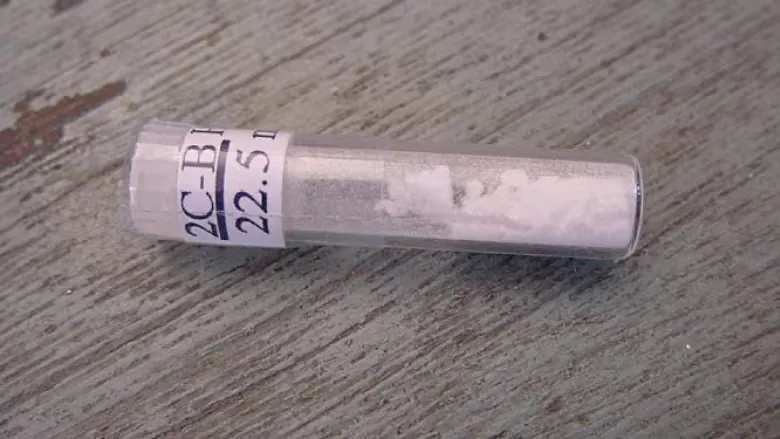
2C-B street names include Venus and Nexus.
What is 2C-B?
2C-B is a synthetic psychedelic drug belonging to the psychedelic phenethylamine class. The “2C” in its name signifies its relation to the 2C family of phenethylamine compounds, which are recognized for their hallucinogenic effects. The “B” specifically refers to this compound’s distinct chemical structure. 2C-B is short for 4-bromo-2,5-dimethoxyphenethylamine. Other closely related 2C drugs include 2C-E and 2C-I, among others. 2C-B is commonly referred to as “Nexus”, and “Venus”.
Well-known sub-classes of phenethylamines are neurotransmitters like dopamine, norepinephrine, and serotonin, which play crucial roles in regulating mood, emotion, and behavior in the brain.
Structurally, 2C-B is a derivative of the neurotransmitter serotonin and bears resemblance to mescaline, a natural psychedelic found in certain cacti, such as Peyote. Although initially popular as a legal substitute for MDMA in the early 2000s, it has gained its own following as a recreational drug in recent years.
2C-B is now classified as a scheduled drug in most jurisdictions.
The Origins of 2C-B
In 1974, Alexander Shulgin discovered 2C-B while exploring a series of compounds derived from the mescaline molecule. Shulgin modified the structure of mescaline and conducted initial tests on himself and a small group of volunteers, discovering its potent psychedelic effects at relatively low doses. Shulgin’s findings on 2C-B and related compounds were published in his book “PIHKAL: A Chemical Love Story,” which has since become a key reference for enthusiasts interested in the chemistry and effects of psychoactive substances.
Does 2C-B product the effects of Molly and LSD combined?
The short answer is: not really. 2C-B, while sharing some properties with both MDMA and LSD, has its own unique effects and characteristics. It’s known for producing visual distortions, altered perceptions of time, and a sense of euphoria, but its effects may not exactly mirror those of MDMA or LSD. Users often report a mix of sensory enhancement, emotional openness, and psychedelic experiences. It’s important to note that the effects of 2C-B can vary significantly depending on various factors, including the individual’s physiology, the dosage, the setting, and the individual’s mental state.
Overall, 2C-B should be considered a distinct substance with its own unique effects rather than a combination of the effects of MDMA and LSD.
Effects of 2C-B
2C-B is renowned for its hallucinogenic properties, often used recreationally for its psychedelic effects. Some common effects include:
- Visual distortions, often characterized by vivid, colorful hallucinations, with patterns, shapes, and colors appearing to move or change.
- Altered perception of time, with users reporting time passing more slowly or quickly than usual.
- Euphoria, accompanied by feelings of happiness, well-being, and often, connection and empathy towards others.
Physical and Psychological Effects of 2C-B
Physical effects may include an increased heart rate, sweating, changes in body temperature, and possible nausea or vomiting. Psychological effects encompass altered thinking, emotions, and perceptions, along with feelings of introspection and self-reflection. These effects can vary depending on the individual, dose, setting, and other factors.
2C-B Interactions with Other Drugs
Ingesting a combination of drugs tends to have less predictable effects than ingesting a single drug, and individual responses may vary. That being said, here’s a description of potential 2C-B interactions with other substances:
- Alcohol:
- Effects: 2C-B and alcohol are both substances that can affect cognitive function and perception. Combining them may intensify the impairment of coordination and judgment.
- Safety Profile: Increased risk of over-intoxication, dehydration, and impaired decision-making. It’s advisable to moderate alcohol consumption.
- Cannabis:
- Effects: Intensified psychedelic effects, potential for increased confusion and altered perception.
- Safety Profile: Caution is advised due to the potential for an overwhelming experience. Moderate cannabis use may be safer than higher doses.
- Amphetamines (e.g., Adderall, methamphetamine):
- Effects: Combining stimulants with 2C-B may increase heart rate, blood pressure, and overstimulation.
- Safety Profile: Potential for cardiovascular issues, anxiety, and increased strain on the heart. Caution is advised, especially for those with pre-existing cardiovascular conditions.
- Cocaine:
- Effects: Increased stimulation and potential for elevated heart rate and blood pressure.
- Safety Profile: Higher risk of cardiovascular issues and anxiety. Caution is advised due to the strain on the cardiovascular system.
- MDMA:
- Effects: Both substances affect serotonin levels, and combining them may increase the risk of serotonin syndrome.
- Safety Profile: There is a potential for overstimulation, increased heart rate, and hyperthermia. This combination is generally discouraged due to the risk of adverse effects.
- LSD:
- Effects: Enhanced psychedelic effects, potential for increased confusion and disorientation.
- Safety Profile: The combination may intensify hallucinogenic experiences. Caution is advised due to the potential for an overwhelming psychedelic experience.
- DMT:
- Effects: Both substances are psychedelics, and combining them may lead to an intensified and prolonged psychedelic experience.
- Safety Profile: Increased risk of confusion and disorientation. The effects may be overwhelming, and caution is advised.
- GHB:
- Effects: GHB is a central nervous system depressant, and combining it with 2C-B may intensify sedation and impair cognitive function.
- Safety Profile: Increased risk of respiratory depression and impaired consciousness. Extreme caution is advised.
- Ketamine:
- Effects: Enhanced dissociative effects, potential for confusion and impaired motor function.
- Safety Profile: Caution is advised due to increased risk of dissociation and impairment.
- SSRIs (Selective Serotonin Reuptake Inhibitors):
- Effects: SSRIs can blunt the effects of psychedelics, potentially reducing the desired effects of 2C-B.
- Safety Profile: The combination may lead to diminished psychedelic experiences. Adjusting doses should be done under the guidance of a healthcare professional.
Drugs Missold as 2C-B
Some substances that have been sold as 2C-B or mixed with it include other synthetic drugs from the phenethylamine family, such as 2C-I and 2C-E. Some mislabeled compounds marketed as 2C-B are MDMA, amphetamines, and cathinones. Additionally, 2C-B obtained from illicit sources may carry risks of contamination with impurities or harmful substances like heavy metals, pesticides, or other toxic compounds.
Using harm reduction techniques, such as testing drugs with reagent test kits, seeking professional help, is crucial to increase the safety of drug use.


